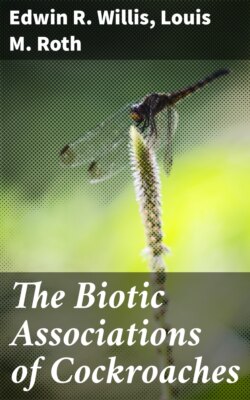Читать книгу The Biotic Associations of Cockroaches - Edwin R. Willis - Страница 242
На сайте Литреса книга снята с продажи.
Ischnoptera deropeltiformis
ОглавлениеNorth Carolina.—Under pine straw on ground in woods (Brimley, 1908).
Georgia.—Under dead oak leaves; under debris in garden; running on ground in pine and oak woods (Rehn and Hebard, 1916).
Indiana.—It is "a ground-frequenting, forest-loving insect, hiding beneath cover or about the edges of deep woodland, more frequently in damp places, and rarely taken beneath bark, signs, or at lights" (Blatchley, 1920).
Missouri.—Twenty to 30 males found resting on heads of wild oats on successive evenings (Rau, 1947).
Texas.—It preferred damp, open woodlands (Hebard, 1943a).
Eastern and southeastern U.S.—Under stone in heavy deciduous forest; under damp, dead leaves on edges of forests; under bark of pine log; in wire grass and sphagnum bordering stream thicket; in leaf mold and rubbish about pothole in pine woods, Pinus caribaea; under debris and leaf mold in hammock; under dead oak leaves in heavy deciduous forest (Hebard, 1917).
Florida.—"This species is distinctly geophilous and appears to prefer damp surroundings" (Rehn and Hebard, 1912). Under boards on very wet ground in everglades; in debris and leaf mold in heavy, junglelike areas of trees, bushes, and vines (Rehn and Hebard, 1914). Adults and numerous nymphs beneath weeds, grass, and other debris washed up on beach of Lake Okeechobee (Blatchley, 1920). Friauf (1953) found this species in leaf duff, leaf mold, and/or decaying wood on ground in these habitats: Dry, ruderal grassland (infrequent), scrub (infrequent), sandhills (occasional), xeric hammock (frequent), mesic hammock (dominant), shrubby, longleaf-pine flatwoods (infrequent), bayhead (dominant), and low hammock (dominant). On open bare soil or bare sand under vegetation in these habitats: Dry, ruderal grassland (infrequent), mesic hammock (dominant), moist, ruderal grassland (infrequent), pond margin (occasional), longleaf-pine flatwoods (infrequent), slash-pine flatwoods (infrequent), and low hammock (dominant). Infrequent in the herbaceous stratum of these habitats: Dry, ruderal grassland, moist, ruderal grassland, and longleaf-pine flatwoods. Infrequent in the shrub stratum of the dry, ruderal grassland habitat. (Friauf, 1953.)
Tennessee.—Taken in traps baited with cantaloupe in a parklike stand of oak, gum, hickory, and tulip trees in a creek bottom, and in a stand of oak on a dry ridge (Walker, 1957).
